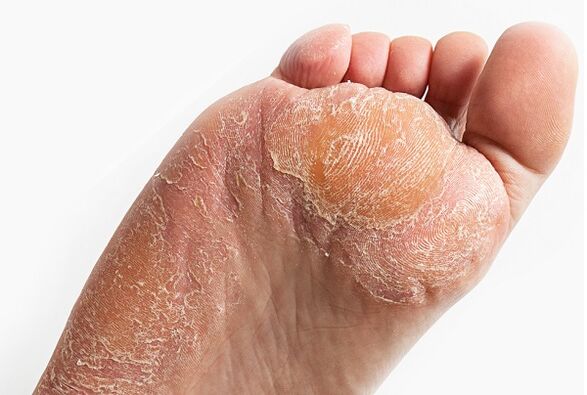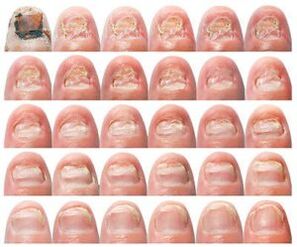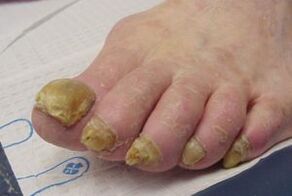Nail fungus, the symptoms of which will be discussed below, most often arises due to neglect of the rules of personal hygiene. Symptoms of nail fungus in most patients appear suddenly, as the infection occurs almost imperceptibly and instantly. Since the measures for the treatment of this disease continue for a long time, it is better for a person who has noticed signs of the disease on the nails to immediately seek help from a doctor.

Factors contributing to the development of the disease
The lesion can be caused by yeasts, molds or skin fungi. In the first case, it is impossible to diagnose the disease immediately. Symptoms of the disease appear 5-6 months after infection. The peeling of the nail develops, a slight irritation of the skin around it. Sometimes the patient is tormented by severe itching.
In the event that the disease has developed due to a skin fungus, then three scenarios are possible:

- The feet, nails and skin of the legs are infected. The fungus can spread not only on the skin of the lower extremities, but also capture the nails of the hands.
- Another type of mycelium only affects the thumbnail or little toenail. Sometimes there is a transition from these mushrooms to the folds between the fingers. Then the skin is affected either on 1-2 folds, or all at once.
- Another type of disease - fungus is limited only to the "occupation" of the nail plate on the little finger or thumb of the lower extremity, but does not spread further.
- The last type of infection is mold. This type of mycelium usually appears in people with severe immune disorders, such as HIV.
The appearance of infection in any case occurs for the following reasons:
- The protective properties of the patient's body have fallen below a critical level.
- The nail was mechanically damaged.
- The man was wearing shoes that were too tight. The blood circulation in the legs was disturbed, which led to the development of an infection.
- Some people have anatomical pathology of the feet, which contributes to the development of fungus.
- Most often, patients who are diagnosed with obesity suffer from the disease. The disease leads to excessive sweating. This creates favorable conditions for the development of the mycelium.
- Fungi grow in diabetic patients.
To prevent illness, you should use only your clothes, shoes and personal hygiene items. It is recommended to decontaminate and clean carpets and shoes in time.
General signs of the disease

The first signs of nail fungus in most people begin to appear as small whitish dots or stripes on the nails. Most people do not pay attention to it, since nothing hurts them, there is no discomfort. If you do not start treatment for mycosis in time, you can start the disease. There will be germination of mycelium on all nail plates, suppuration of the skin around the affected nails will begin. In severe cases, the disease spreads to deep tissue structures. This threatens the development of gangrene and amputation of the foot or even the entire leg.
At the second stage of the disease with mycosis, the natural shine of the nail plates disappears. Nails change color. They are yellow with brown or white stripes. The upper part and the side surfaces of the nail are often deformed. Such changes are clearly visible to the eye.
At the last stage of the disease, the nail plates become very brittle, the inflammatory process begins on the cuticle. A person can completely lose a nail. But the mushrooms don't stop there. They continue to spread to all the nail plates, then move on to the skin of the leg, that is, they capture the feet.
The patient himself can recognize the disease in the second and third stages, as the nails turn yellow or brown (sometimes they turn black). The nail rises from its bed, acquires increased fragility, quickly breaks.
Symptoms of the disease in the initial stage
If a person has developed nail fungus, the symptoms of the disease are practically absent at first. But then, 2-3 months after the penetration of the skin fungus and its attachment to the nails, you can notice the manifestation of such signs of the disease:
- On the surface of the skin near the affected plaque, a slight redness first develops.
- Then the person feels a burning sensation in that area.
- Severe itching develops, inflammation begins.
- Subsequently, places with increased humidity develop in these areas.
- There is a thickening of the nail and its keratinization.
As soon as a person notices these signs of nail fungus, they should be examined and then start treatment.
Depending on the type of fungal infection in the later stages of the development of mycosis, the diseased nail plate is painted in different colors. At the first stage of the development of the disease, the affected area may turn white or green. The spots on it will be located along the surface or look like round dots. At the same time, the thickness of the plate in most patients does not change, and in many cases the nail retains its natural shine. Itching in any case is very strong, it is impossible to get rid of it immediately. If the patient noticed signs of mycosis in time, you can get rid of burning and itching using such drugs as miconazole, clotrimazole and similar drugs. But you should not be treated alone, it is better to do this under the supervision of a doctor. In case of error or non-compliance with the doctor's recommendations, the mycelium will instantly spread to healthy areas, which will complicate the treatment.
Further development of the disease
Fungus on the toenails, if left untreated, can deprive the nails of their natural color, and the color of the surface of the affected area will be yellow. There is delamination of the nails. They may start to break down. Along with this, the patient develops intolerable itching on the skin around the affected area. The cracking of the substance of the nail plates begins. The burning intensifies. Some patients may develop dysbacteriosis, they feel bad, complain of weakness throughout the body. Perhaps the development of drowsiness.

First, the mycelium completely changes the color of the surface of the plaques, then their thinning begins. Then the diseased nail is rejected and the infection penetrates into the skin structures. The itching gets worse.
At the last stage of the disease, the surface of the diseased nail plates becomes scale-like. Depending on the type of fungus that struck the person, the thickening of the nails begins, their delamination. They break quickly. Symptoms of the disease include the following:
- The edges of the plates become very brittle. Sometimes this causes pain in the patient.
- The shape of the plaques is severely distorted and a scaly surface may develop.
- The color of the affected area changes from yellow to black.
- The insertion of parts of the plates into the skin begins.
- A whitish or yellowish coating appears under the fingernails. This is due to their coat of the bed.
- The itching is very strong, almost unbearable. The burning of the skin around the affected areas increases again.
If these symptoms appear and treatment is started in time, it will still continue for a long time. You can be infected with a disease in 4-5 seconds, and it is very difficult to cure the disease. It usually takes 3-6 months. It is not recommended to abandon treatment due to possible complications that may lead to surgery. So you have to listen to yourself carefully. If the first symptoms are detected and the treatment is started immediately, then it is possible to complete the treatment faster, while preserving your nails.





























